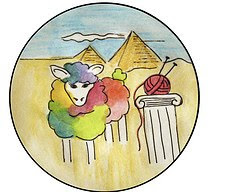I divide my sock yarn stash into two categories: my “regular” yarns and my” good” yarns. I even store them separately; my regular yarns are in one of my night table drawers, while my good yarns enjoy a more privileged position in a basket in the living room. My regular yarns consist of conventional, commercially-dyed brands, usually sold in balls for about $10-$15 per 100g, and are destined to become plain, stockinette socks. I always have at least one pair of “plain socks” on the go to provide mindless knitting while waking up in the morning, riding in the car, or watching tv. I hardly even have to look at them, except when it comes to working the heels and toes. My good yarns, as I’m sure you’ve guessed, are of the hand-dyed and hand-painted variety, each skein a unique work of art and costing considerably more than my regular yarns. They are carefully selected, then tucked away, awaiting the ideal pattern to showcase their beauty.
In the spring of 2007 I was lucky enough to score a skein of SweetGeorgia sock yarn, just after Felicia had announced that she was indefinitely suspending operations to do some travelling and her yarn had become an even hotter commodity than usual (she has since resumed dyeing). I even managed to acquire the one colourway that had captured my heart: Coal Harbour. At the time I had only just begun to buy good sock yarn so I treasured this skein and vowed to make it into something special. I eventually decided on Pomatomus and knit almost a whole sock before losing interest and abandoning the project. This past July I admitted defeat, frogged the sock, and reclaimed the yarn for another pair but they didn’t work out either and the yarn went back into my stash.
A couple of weeks ago I finished my latest pair of plain socks and opened the drawer to select a ball for a new pair but nothing grabbed me so I shut the drawer and put the decision off for another day. I knew I had a fairly long car trip coming up and would want to have some new socks on the go but I couldn’t make up my mind. All those yarns seemed so ordinary and I was craving something a little more spectacular. The thing was, I already had several patterned socks in progress and besides, I didn’t want to “waste” my good yarn on plain socks. That’s when I remembered the photograph that had initiated my love affair with the Coal Harbour sock yarn.
As I cast on 60 stitches and began the 2x2 ribbing, I reveled in the soft feel of the yarn. When I switched to stockingette I enjoyed watching the watercolour shades of aqua and seafoam and purple stack up into irregular but appealing stripes.
 Each stitch brought me pleasure and I didn’t want to look out the car window or watch tv. I realized that sometimes the perfect pattern for a hand-dyed yarn is no pattern at all.
Each stitch brought me pleasure and I didn’t want to look out the car window or watch tv. I realized that sometimes the perfect pattern for a hand-dyed yarn is no pattern at all.On the flip side, just as some multicoloured yarns benefit from a simple stitch pattern, it is also true that many complex stitch patterns benefit from a simple yarn. For example, my newly completed Stricken socks by Cookie. A.
 Many of the other featured designers for this year’s upcoming Sockdown challenges also specialize in detailed textured or lace patterns so I am deliberately acquiring a bigger collection of solid and semi-solid yarns to highlight their intricacy.
Many of the other featured designers for this year’s upcoming Sockdown challenges also specialize in detailed textured or lace patterns so I am deliberately acquiring a bigger collection of solid and semi-solid yarns to highlight their intricacy.I don’t anticipate losing my affection for hand-dyed yarns any time soon but I will be less likely to hoard them, waiting for that perfect pattern. Instead, I will allow myself to enjoy them for their own sake, to find beauty in their simplicity. I’ve decided that more of my good yarns are going to become not-so-plain, stockingette socks.



1 comment:
Lovely socks and lovely knitting!
Post a Comment